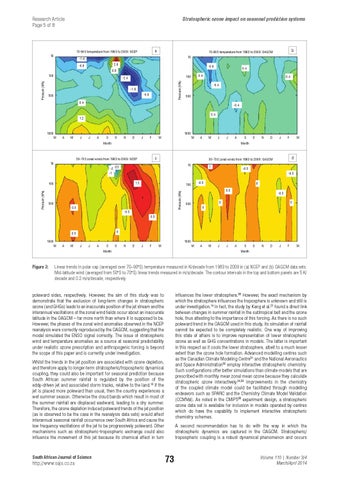Research Article Page 5 of 8
Stratospheric ozone impact on seasonal prediction systems
a
70-90S temperature from 1983 to 2009: NCEP
10
-1.6 2.8
-0.8
-0.8
0.4
0.8 0.4
100
-2.4 Pressure (hPa)
Pressure (hPa)
100
-1.6 -0.8
500
0.4 -0.4
500
0.4
-0.4 0.4
1.2
1000 M
1000 A
M
J
J
A
S
O
N
D
J
F
M
M
A
M
J
J
A
Month
c
O
N
D
J
F
M
d
50-70S zonal winds from 1983 to 2009: OAGCM 10
-2 3.5 -1
1
-0.5 -0.5
1.5
-0.5
100 Pressure (hPa)
100
500
S Month
50-70S zonal winds from 1983 to 2009: NCEP 10
Pressure (hPa)
b
70-90S temperature from 1983 to 2009: DAGCM 10
0.5 -0.5
0 0.5
-0.5
0
500
0
0
0.5
0
0.5 1000 M
1000 A
M
J
J
A
S
O
N
D
J
F
M
M
Month
Figure 3:
A
M
J
J
A
S
O
N
D
J
F
M
Month
Linear trends in polar cap (averaged over 70–90°S) temperature measured in K/decade from 1983 to 2009 in (a) NCEP and (b) OAGCM data sets. Mid-latitude wind (averaged from 50°S to 70°S) linear trends measured in m/s/decade. The contour intervals in the top and bottom panels are 5 K/ decade and 0.2 m/s/decade, respectively.
poleward sides, respectively. However, the aim of this study was to demonstrate that the exclusion of long-term changes in stratospheric ozone (and GHGs) leads to an inaccurate position of the jet stream and the interannual vacillations of the zonal wind fields occur about an inaccurate latitude in the OAGCM – far more north than where it is supposed to be. However, the phases of the zonal wind anomalies observed in the NCEP reanalysis were correctly reproduced by the OAGCM, suggesting that the model simulated the ENSO signal correctly. The issue of stratospheric wind and temperature anomalies as a source at seasonal predictability under realistic ozone prescription and anthropogenic forcing is beyond the scope of this paper and is currently under investigation.
influences the lower stratosphere.50 However, the exact mechanism by which the stratosphere influences the troposphere is unknown and still is under investigation.14 In fact, the study by Kang et al.21 found a direct link between changes in summer rainfall in the subtropical belt and the ozone hole, thus attesting to the importance of this forcing. As there is no such poleward trend in the OAGCM used in this study, its simulation of rainfall cannot be expected to be completely realistic. One way of improving this state of affairs is to improve representation of lower stratospheric ozone as well as GHG concentrations in models. The latter is important in this respect as it cools the lower stratosphere, albeit to a much lesser extent than the ozone hole formation. Advanced modelling centres such as the Canadian Climate Modeling Centre51 and the National Aeronautics and Space Administration52 employ interactive stratospheric chemistry. Such configurations offer better simulations than climate models that are prescribed with monthly mean zonal mean ozone because they calculate stratospheric ozone interactively.24,53 Improvements in the chemistry of the coupled climate model could be facilitated through modelling endeavors such as SPARC and the Chemistry Climate Model Validation (CCMVal). As noted in the CMIP528 experiment design, a stratospheric ozone data set is available for inclusion in models operated by centres which do have the capability to implement interactive stratospheric chemistry schemes.
Whilst the trends in the jet position are associated with ozone depletion, and therefore apply to longer-term stratospheric/tropospheric dynamical coupling, they could also be important for seasonal prediction because South African summer rainfall is regulated by the position of the eddy-driven jet and associated storm tracks, relative to the land.12 If the jet is placed more poleward than usual, then the country experiences a wet summer season. Otherwise the cloud bands which result in most of the summer rainfall are displaced eastward, leading to a dry summer. Therefore, the ozone depletion induced poleward trends of the jet position (as is observed to be the case in the reanalysis data sets) would affect interannual seasonal rainfall occurrence over South Africa and cause the low frequency vacillations of the jet to be progressively poleward. Other mechanisms such as stratospheric-tropospheric exchange could also influence the movement of this jet because its chemical effect in turn
South African Journal of Science
http://www.sajs.co.za
A second recommendation has to do with the way in which the stratospheric dynamics are captured in the OAGCM. Stratospheric/ tropospheric coupling is a robust dynamical phenomenon and occurs
73
Volume 110 | Number 3/4 March/April 2014
